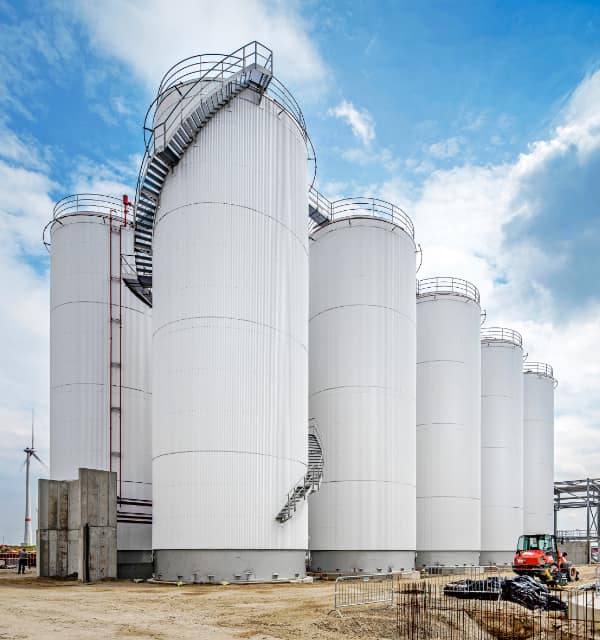“Cranes hoisted the tanks up to forty meters in the air”
The preparations for our new terminal in the port of Antwerp are in full swing. One of the most impressive and large-scale activities is the installation of the various tanks on site. On 13 and 14 July, the first ten tanks were delivered and installed in Antwerp. Ronald Ooms, director at Standic Antwerp, was one of the spectators. “Cranes hoisted the tanks up to forty meters in the air.”
STAYING ON SCHEDULE
“The installation of the first tanks is an important part of the construction of our new chemical storage terminal in Antwerp. In the first building phase, a total of 79 tanks will be installed, divided among eight tank pits. Since the main focus of our Antwerp terminal is chemical storage, the tanks are not as big as, for example, tanks for oil storage. This means we were able to produce the tanks at a tank manufacturer in Noord-Holland, the Netherlands, instead of having to build them on-site. The biggest advantage of this is that we were able to focus on the civil activities while the tanks were being built. Think about piling, laying the foundation, building the tank pits. This way, we were able to work very efficiently and stay on schedule, helping to make sure the terminal will be ready for operation as fast as possible.”
SAFETY AND SUSTAINABILITY
It was great to see ten tanks of 24 meters each being transported from Noord-Holland to Antwerp, through inland water ways and canals. “Large cranes were used to place the tanks on two pontoons, pulled and pushed by two tugboats. It took three days to move the tanks to the port of Antwerp. Over there, cranes had been built up on the quay. They hoisted the tanks up to forty meters in the air, to safely place them on the right foundation. We paid a lot of attention to the civil activities, like laying the foundation. Since the tanks will stay here for at least fifty years, a strong foundation guarantees optimal safety and sustainability.”
Construction of the new terminal is going smoothly, and at the end of July the next load of tanks will be delivered, followed by another batch on 10 August. “Before the end of August, the tanks for four of the eight tank pits will be delivered and installed. In the meantime, we will continue our other activities, including construction of the pipes and cables, installation of the pumps and other equipment and organization of the loading places.
RECRUITING A NEW, DEDICATED TEAM
We have also made a strong effort to raise an enthusiastic, dedicated crew for our new terminal. “We are happy to have taken on a new terminal manager and a safety manager, and there have been a lot of job interviews to further expand the team from twenty to thirty people. Together with our Human Resources department, we developed a plan to train our new colleagues as well as possible. The training period consists of four stages. First, colleagues will learn everything about safety, processes and products during a theoretical VOTOB training. Second, they will attend practical trainings at our terminal in Dordrecht, the Netherlands. Experienced colleagues will train them in how to load and unload ships, trucks and trains, and in safety and quality aspects. Third, starting fall this year, parts of the Antwerp terminal will be operational. Here, new colleagues will assist with commissioning, i.e. testing of all the equipment, processes and technologies, to learn how our own terminal works. Last but not least, we will focus on teambuilding to make sure we create a dedicated, close-knit team.”
In conclusion, Ronald is very happy and excited to be part of the construction of our new terminal. “It’s great to see that, despite COVID-19, we are still on track to make sure the first phase of the terminal will be operational by Q1 2021. Antwerp is a well-known, highly developed location when it comes to the chemical industry, and I look forward to being part of this region with Standic.”
